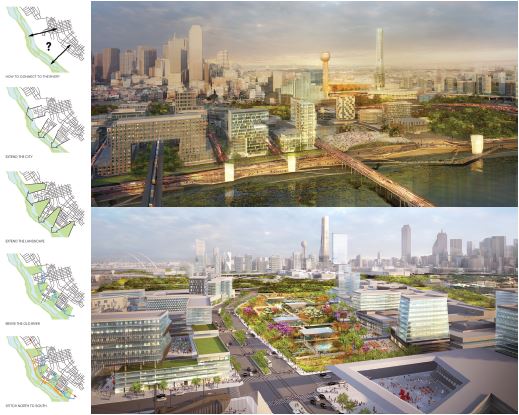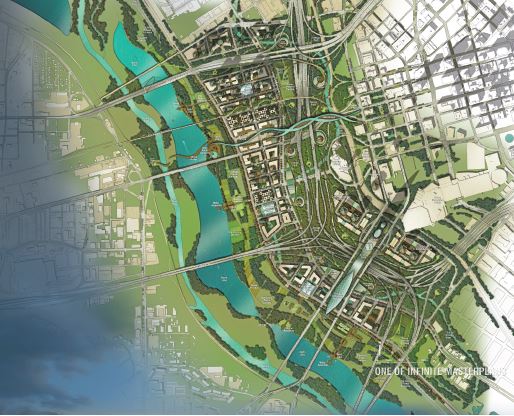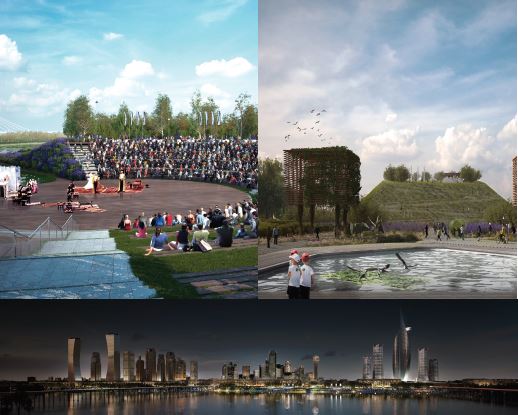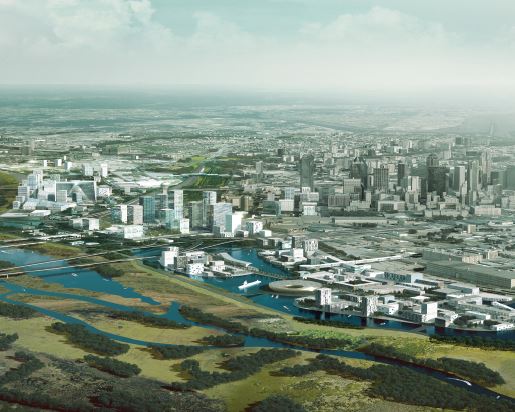CONNECTED CITY CHALLENGE
Professional Submissions
Finalists
Stoss+SHoP
HYPERDENSITYHYPERLANDSCAPE


Hyper Density Hyper Landscape is a strategy and vision for Dallas's future, one that reunites the city with its river and sets the stage for transformation starting now. HDHL intensifies the existing qualities of Dallas's urban and natural landscapes and, in so doing, will help to realize the full potential of the region's development opportunities and economic prosperity. HDHL is about dense city districts full of energy and exuberance, and intense landscapes that play many roles- social, economic, and environmental. It builds off Dallas's entrepreneurship, natural resources, business acumen, and diverse urban lifestyles. HDHL is uniquely Dallas, re-imagined.
At the core of this approach are three new, dynamic, mix-used neighborhoods interspersed within regions of variegated, programmed, and sustainable landscape. The expansion of the city grid and the city green has mutually beneficial properties that make Dallas more livable, but also more vibrant, accessible, and completive. At the center of this landscape is the old Trinity River, brought back to life as an innovative series of active public spaces, wetlands, and gardens that double as water filters and flood basins. These new spaces will be inter-connected with a new light-ail system along Riverfront Boulevard and a pedestrian promenade suspended along the proposed toll-road, making the Trinity floodplain the most exciting public space in Texas.
This project intensifies the growing energy and vibrancy in the heart of Dallas, where people can live, work, and play, and thrives off the spontaneous and unexpected interactions among one another. It brings the experience of nature directly to their doorsteps, allowing for urban and landscape experiences not possible anywhere else, and filling in spaces (like transportation right-of-ways) that urban development cannot.
Hyper Density. Hyper Landscape. Hyper Connected. Dallas made new.
Biography
Stoss is a cutting-edge design firm that believes in the productive role of landscape in making and re-making of cities and social space. We work primarily in the public realm, regardless of whether our clients are cities, public agencies, institutions, or private interests. We are involved in projects of many kind: urban, campus, and ecological space; regional and urban strategies; multi-scale landscape infrastructures; development and re-development projects; parks and open spaces; furnishings and exhibitions.
SHoP is a leader in rethinking architectural practice from the sedentary status- quo to a mode of engaging with rapidly changing economic, social, and regulatory contexts. Our commitment to challenging the entire process of building has proven that beauty and technological proficiency are not mutually exclusive, and our "think-tank" business model has allowed us to expand our influence past form making and into software design, branding, real estate development, construction, and the co-development of new sustainable technologies.
Together, we are as interested in how projects work for people and clients as we are in what they look like. We believe it's possible to be both inventive and pragmatic, beautiful and functional. We're interested in simple technical efficiencies and hybrid solutions that can do many things at the same time- most importantly, enriching the lives and experiences of people.
Our work and practices have been recognized by place making organizations, real estate organizations, and the design / arts communities alike- including a Cooper-Hewitt National Design Award for each firm.
Ricardo Bofill Taller de Arquitectura
Trinity and Downtown


The strategic plan aspires to be part of a collective dream, from the past Native American history to contemporary culture. The project's vision ensures that Downtown Dallas grows with a comprehensive integration of ecology, transportation, land-use and socio-economy.
The urban sequence extends from the Arts District, lengthening the pedestrian corridor to the new Science and Nature Program and Energy Park, and Leisure Trinity Park and new Sunset Promenade.
"D walk" is a concept that connects the DMA to the Perot Museum, across to the JFK Memorial, and across through the new bridges, connecting Main Street with the Rive, the Bio Dome, parks and new lakes.
The original Blackland prairie becomes ecological support that provides an intense street level hard/soft landscape design, with planting along all main streets, and a network of magnets: the +E Museum& Park (with pavilions) and outdoor neighborhood markets, which regenerate nature through local/global bio-mimesis.
The plan integrates the toll-road and highways through a unified urbanism that links 4 new Riverfront Districts to Downtown through a multifaceted mobility scheme that pulls citizens away from a singular mobility mode, adding car-sharing, Park & Ride, and BRT(rapid bus 90%, rail 10%). The scheme promotes development around a series of inter-change hubs that seamlessly connect transport modes, and ensure that one's home is walking distance from jobs and daily activities.
District by district design and inter-urban connections create a sense of place and identity, a "genius-loci" from which to grow. The Trinity Riverfront promenade becomes the urban/ natural spine, with magnets to activate a living ground floor where interior and exterior streets are connected, leading to multi-level decks overlooking the Trinity Lakes and Parks.
Biography
RIcardo Boffill Taller de Arquitectura(RBTA) is an international architecture studio based out of Barcelona, Spain. RBTA's scope encompasses a comprehensive vision of architecture, which includes urban planning, landscape, interior, lighting and furniture design. Projects can be found throughout h world, from Europe to the USA, China Japan and India. Since 1963, RBTA has over 1,000 projects in 50 cities.
With a focus on "strategic urbanism", RBTA cooperates in master planning with cities from around the world, with projects such as Great Moscow, Place de I 'Europe in Luxembourg, Boston Central Artery, Savona waterfront, Madrid Castellana, and Barcelona New Port.
In the field of public facilities, understood as "urban magnets", RBTA completed the National Theatre of Catalonia in Barcelona, The Madrid Congress Center, the Arsenal Auditorium in Metz, Miguel Delibes Cultural Center a performing arts center in Valladolid, and the Convention and Exhibition Center in A Coruna.
Urban parks, understood as fields for integrated urbanism, are a core discipline for RBTA, having completed, amongst theirs, Valencia's Turia Park, Madrid's Manzanares, and Barcelona's Rosa dels Vents. Ricardo Bofill's work earned various accolades throughout the years including the Vittorio de Sica Archictecture Prize, theBund Deitscher Architkter and the Chicago Architecture Award.
OMA*AMO
Two Rivers, Two Cities


The area between Dallas and the Trinity River Corridor is currently dominated by highways and underdeveloped land. This zone forms a moat around Dallas, truncating downtown at Dealey Plaza and severing the city from the waterfront. Our vision seeks to connect downtown Dallas and the Trinity River Corridor and to reconceive the zone between them as a vibrant new linear city.
Daylighting and filtering existing watersheds and culverts reconstitutes the Old Trinity River to create a new ecological spine along the Riverfront Boulevard. This new ecology provides a foundation for development by increasing property values and establishing a new, legible amenity zone adjacent to downtown.
To connect across I-35E and the railway, four strategic interventions stretch over and under them. At the North and South, new pedestrian bridges provide access to key DART stations. Closer to Downtown, Dealey Plaza and the viaducts at Houston and Jefferson are Transformed to provide new gateways into the site.
Within the site, two arc-shaped loops define development, creating new connections between downtown Dallas and the Trinity and framing the new river. Where the two arcs intersect the rejuvenated waterway and Riverfront Boulevard, a chain of Cultural venues and outdoor amenity areas establishes a central spine from north to south.
Along the spine, an archipelago of urban islands stretches from Rock Island at the south to the Design District at the north. Each Island is a unique programmatic mix linked strategically to the areas that surround it.
Biography
OMA's buildings and masterplans around the world insist on intelligent forms while inventing new possibilities for content and everyday use. OMA is led by ten partners - Rem Koolhaas, Ellen van Loon, Reinier de Graaf, Shohei Shigematsu, Iyad Alsaka, David Gianotten, Chris van Duijn, Ippolito Pestellini Laparelli, Jason Long and Michael Kokora - and maintains offices in Rotterdam, New York, Beijing, Hong Kong, Doha and Dubai.
The counterpart to OMA's architectural practice is AMO, a research studio based in Rotterdam. While OMA remains dedicated to the realization of buildings and masterplans, AMO operates in areas beyond the traditional boundaries of architecture, including media, politics, sociology, renewable energy, technology, fashion, curating, publishing, and graphic design.
Under the direction of Partner Shohei Shigematsu, the New York office is currently overseeing the construction of the Musee national des beaux-arts du Quebec, a private foundation on the Philippines, and a new performance space for Marina Abramovic.
OMA’s partners in the Connected City Design Challenge include landscape architects Mia Lehrer + Associates, whose masterplan for the LA River is set to transform the city’s relationship to its long-neglected river. Other partners include Dallas-based landscape architects Kevin Sloan Studio as well as sustainability experts RWDI and transportation specialists Mobility in Chain.